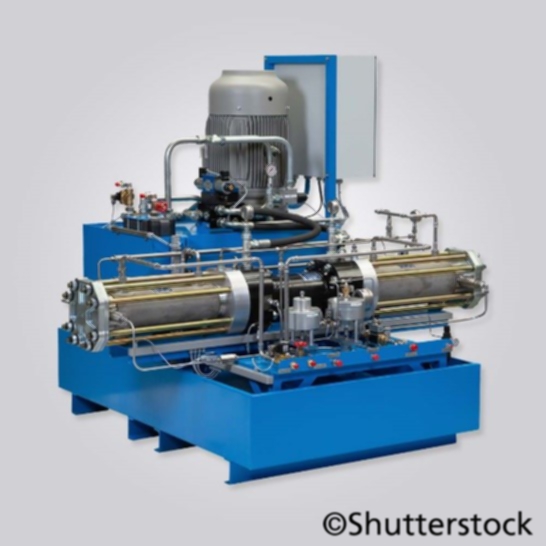Wasserstoffkompressor
Technologie: Speicher
Stichworte: Wasserstoff, erneuerbare Energien, dezentrale Wärmeversorgung, EFH, MFH, Gebäude, Wohngebäude, Neubau, GHD

Kurzbeschreibung: Wasserstoff hat, gemessen am Gewicht, den höchsten Energiegehalt. Aber die Wasserstoffdichte ist im atmosphärischen Zustand mit etwa 90g/m3 sehr gering. Daher muss Wasserstoff komprimiert werden, um eine nutzbare Energiedichte zu erreichen. Es gibt zwei marktübliche Verdichtertypen, den Kolben- und den Membrankompressor. Der Kolbenkompressor erreicht vor allem in der mehrstufigen Verdichtung, wegen des hohen erreichten Enddrucks und ihrer Flexibilität in Bezug auf Größe und Leistung, sehr gute Leistungswerte. Der Membrankompressor hat sich aufgrund des hohen Durchsatzes, geringen Stromverbrauchs und geringen Kühlbedarfs für Wasserstoffanwendungen als sehr effektiv erwiesen.
| Kolbenkompressor | Membrankompressor | ||
|---|---|---|---|
| Technische Parameter | |||
| Anlagentyp | Mechanischer Kompressor | Mechanischer Kompressor | |
| Anwendung | Energispeicherung, Wasserstoff-Anlagen, Wasserstoff-Tankstelle, Befüllung von Fahrzeugtanks | chemische Industrie, Energiespeicherung, Wasserstoff-Tankstelle, Befüllung von Fahrzeugtanks | |
| Energieverbrauch | [kWh/kg] | 10,8 (von 5 bis 1000bar) [1]Sdanghi, G., Maranzana, G., Celzard, A., Fierro, V.: Review of the current technologies and performances of hydrogen compression for stationary and automotive applications. Renewable and Sustainable Energy Re-views 102 (2019), S. 150–170. | k.A. |
| Druck | [bar] | 250-1.000 (1-5 stages) [1]Sdanghi, G., Maranzana, G., Celzard, A., Fierro, V.: Review of the current technologies and performances of hydrogen compression for stationary and automotive applications. Renewable and Sustainable Energy Re-views 102 (2019), S. 150–170. | 97-1.000 (1-5 stages) [1]Sdanghi, G., Maranzana, G., Celzard, A., Fierro, V.: Review of the current technologies and performances of hydrogen compression for stationary and automotive applications. Renewable and Sustainable Energy Re-views 102 (2019), S. 150–170. |
| Durchsatz | [N m3/h] | 30-10.000 [1]Sdanghi, G., Maranzana, G., Celzard, A., Fierro, V.: Review of the current technologies and performances of hydrogen compression for stationary and automotive applications. Renewable and Sustainable Energy Re-views 102 (2019), S. 150–170. | 5,5-700 [1]Sdanghi, G., Maranzana, G., Celzard, A., Fierro, V.: Review of the current technologies and performances of hydrogen compression for stationary and automotive applications. Renewable and Sustainable Energy Re-views 102 (2019), S. 150–170. |
| Wirkungsgrad (Kompressor) | [%] | 50-80 [2]A. John Cornish, 2011: Hydrogen Fueling Station Cost Reduction Study: Survey Results and Analysis of the cost and efficiency of various in‐operation Hydrogen Fueling Stations. EPC, Lakewood, Colorado. | 65-85 [1]Sdanghi, G., Maranzana, G., Celzard, A., Fierro, V.: Review of the current technologies and performances of hydrogen compression for stationary and automotive applications. Renewable and Sustainable Energy Re-views 102 (2019), S. 150–170. |
| Wirkungsgrad (System) | [%] | Ca.45 [2]A. John Cornish, 2011: Hydrogen Fueling Station Cost Reduction Study: Survey Results and Analysis of the cost and efficiency of various in‐operation Hydrogen Fueling Stations. EPC, Lakewood, Colorado. | 44,3 [2]A. John Cornish, 2011: Hydrogen Fueling Station Cost Reduction Study: Survey Results and Analysis of the cost and efficiency of various in‐operation Hydrogen Fueling Stations. EPC, Lakewood, Colorado. |
| Ökonomische Bilanz | |||
| Investitionskosten | [€] | 29.170 [2]A. John Cornish, 2011: Hydrogen Fueling Station Cost Reduction Study: Survey Results and Analysis of the cost and efficiency of various in‐operation Hydrogen Fueling Stations. EPC, Lakewood, Colorado. | 50.908 [2]A. John Cornish, 2011: Hydrogen Fueling Station Cost Reduction Study: Survey Results and Analysis of the cost and efficiency of various in‐operation Hydrogen Fueling Stations. EPC, Lakewood, Colorado. (Mittelwert von 7 Anbietern) |
| Betriebsgebundene Kosten | [1/a] | 5% der Investitionskosten [1]Sdanghi, G., Maranzana, G., Celzard, A., Fierro, V.: Review of the current technologies and performances of hydrogen compression for stationary and automotive applications. Renewable and Sustainable Energy Re-views 102 (2019), S. 150–170. | 5% der Investitionskosten [1]Sdanghi, G., Maranzana, G., Celzard, A., Fierro, V.: Review of the current technologies and performances of hydrogen compression for stationary and automotive applications. Renewable and Sustainable Energy Re-views 102 (2019), S. 150–170. |
| Verbrauchsgebundene Kosten | [ct/kWh] | 32,05 (durchschnittlicher Strompreis für Privatkunden 2020) [3]Bundesnetzagentur, Bundeskartellamt, 2021: Monitoringbericht Energie 2020. | 32,05 (durchschnittlicher Strompreis für Privatkunden 2020) [3]Bundesnetzagentur, Bundeskartellamt, 2021: Monitoringbericht Energie 2020. |
